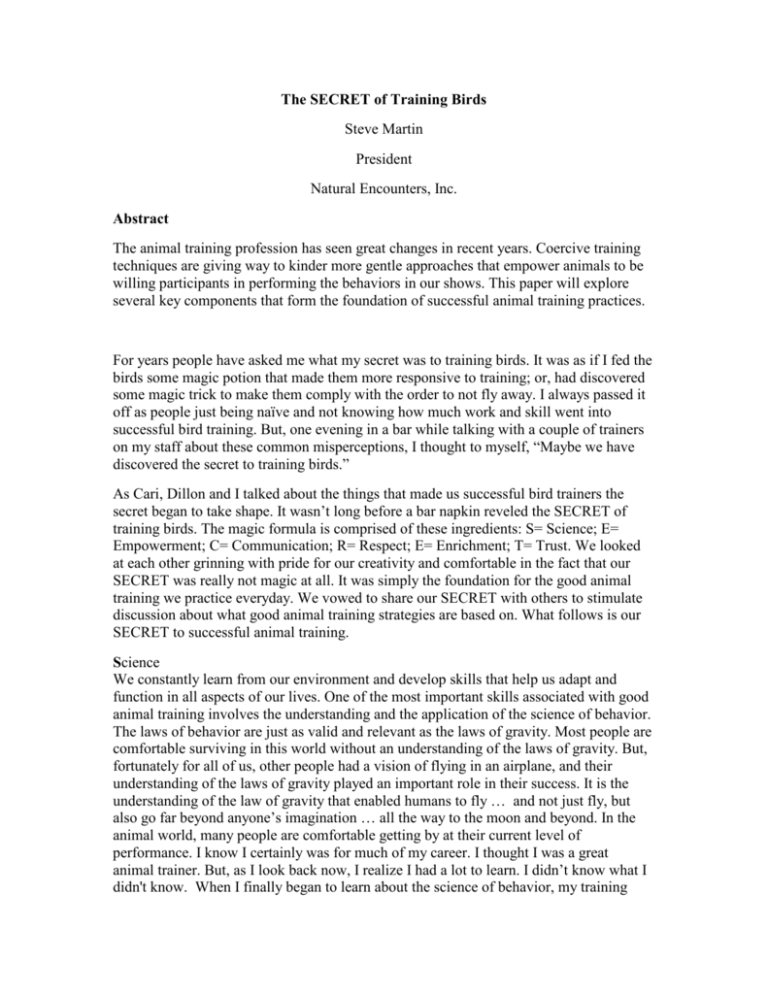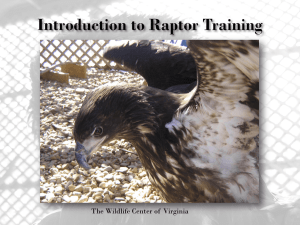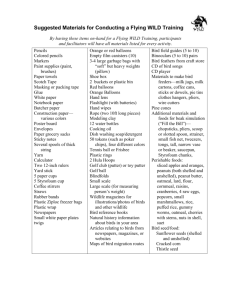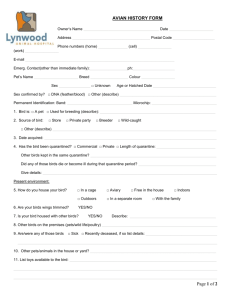The SECRET of Training Birds Steve Martin President Natural
advertisement

The SECRET of Training Birds Steve Martin President Natural Encounters, Inc. Abstract The animal training profession has seen great changes in recent years. Coercive training techniques are giving way to kinder more gentle approaches that empower animals to be willing participants in performing the behaviors in our shows. This paper will explore several key components that form the foundation of successful animal training practices. For years people have asked me what my secret was to training birds. It was as if I fed the birds some magic potion that made them more responsive to training; or, had discovered some magic trick to make them comply with the order to not fly away. I always passed it off as people just being naïve and not knowing how much work and skill went into successful bird training. But, one evening in a bar while talking with a couple of trainers on my staff about these common misperceptions, I thought to myself, “Maybe we have discovered the secret to training birds.” As Cari, Dillon and I talked about the things that made us successful bird trainers the secret began to take shape. It wasn’t long before a bar napkin reveled the SECRET of training birds. The magic formula is comprised of these ingredients: S= Science; E= Empowerment; C= Communication; R= Respect; E= Enrichment; T= Trust. We looked at each other grinning with pride for our creativity and comfortable in the fact that our SECRET was really not magic at all. It was simply the foundation for the good animal training we practice everyday. We vowed to share our SECRET with others to stimulate discussion about what good animal training strategies are based on. What follows is our SECRET to successful animal training. Science We constantly learn from our environment and develop skills that help us adapt and function in all aspects of our lives. One of the most important skills associated with good animal training involves the understanding and the application of the science of behavior. The laws of behavior are just as valid and relevant as the laws of gravity. Most people are comfortable surviving in this world without an understanding of the laws of gravity. But, fortunately for all of us, other people had a vision of flying in an airplane, and their understanding of the laws of gravity played an important role in their success. It is the understanding of the law of gravity that enabled humans to fly … and not just fly, but also go far beyond anyone’s imagination … all the way to the moon and beyond. In the animal world, many people are comfortable getting by at their current level of performance. I know I certainly was for much of my career. I thought I was a great animal trainer. But, as I look back now, I realize I had a lot to learn. I didn’t know what I didn't know. When I finally began to learn about the science of behavior, my training skills started to improve. Not only did I begin to understand why many of the things I was doing worked, but more importantly, I began to understand how to do things better in the future. Understanding and applying the science of behavior took me to a level of performance that I never knew existed. The science of behavior helps us plan our course, solve our problems, and fuels our assent to higher levels of performance. Empower The best animal trainers go to great lengths to give their animals power in their environment. There are many ways to empower animals. You can give an animal the power of escape by training it in an open area instead of a confined space. This often leads to an animal being more likely to show comfortable body language at your approach, and more willing and motivated to participate in training sessions. Holding a raptor’s jesses is an obvious way of taking away an animal’s power to escape, but even walking that bird next to a wall or through a door way also limits its power of escape. The more power of escape you can give a bird, the more likely the bird is to be a willing participant in your training sessions. Empowering animals to shape your body language is another one of the secrets to good animal training. A perceptive trainer might notice the subtle signs of discomfort in an animal when he or she approaches that animal. If the trainer stops or backs up at this time, the animal might relax and even gain some confidence when the trainer backs away. If a parrot lashes out to bite you, and you back away in response to the biting action, you give the bird a way to say no. When you back away at the less intense signs of discomfort, the bird will not need to lunge or bite. With the power to control your proximity, you may find that animals choose to draw you closer. Communicate The best training occurs when there is a clear exchange of information. A trainer uses cues to tell an animal what he or she wants it to do, and the animal tells the trainer through its body language if it wants to participate or not. The best animal trainers are sensitive to even the most subtle expression of body language from the animal they are working with. This two-way communication, where the animal’s voice is as important as the trainer’s, sets the stage for successful training. Great trainers practice honest communication and avoid doing anything that might trick or confuse an animal. They demonstrate the skill of exact timing of the bridge to precisely mark the instance of the right behavior and communicate to the animal exactly what was required for reinforcement. They also understand how to shape a behavior by using small approximations. Consistent pairing of the bridging stimulus with a primary reinforcer provides clear communication that helps the animal understand the meaning of the bridge. Too often animal trainers do not follow the bridge with a food reward and end up diluting the strength of the bridge to mark the right behavior clearly. Clear communication is essential to good training. Respect The best trainers respect that each animal is an individual. It is unique, special and important in its own right. Just because two animals are of the same species, even raised by the same parents in the same nest, does not mean that their behavior will be the same or even similar. Behavior is more a product of experience than genetics. No two animals behave the same, not even identical twins. Each animal has its own preference for reinforcers, its own perspectives on different situations, and its own individual behavior that has been shaped by countless experiences with its environment. Sometimes these behaviors can be undesirable, or problem behaviors, which cause people to attach various labels to a bird, like “screamer,” “biter,” or “aggressive.” We show the animal respect when we accept that these behaviors serve a function, or meet a need for the bird, and we try to find ways that we can meet these needs another way. Though many people like to make the comparison, parrots are not the mental equivalent of a child. They are beautiful, intelligent, amazing animals, nothing less. All animal trainers should respect that their birds are their partners and it is their duty to provide the most positive living and working environment possible. Enrich Enrichment is more than putting toys in a parrot’s cage or throwing a boomer ball in a condor exhibit. Enrichment involves allowing animals an opportunity to use their senses and adaptations to “earn” a living, which is something we take away from them when we put them in cages. No matter how large, beautiful, and interesting a cage might be, it is still a cage with limited opportunities for novel experiences. Life in captivity is rather predictable and routine. The same food is delivered by the same person, at the same time, in the same bowl every day. Enrichment allows animals an opportunity to interact with their environment, to make decisions, take actions and experience the positive consequences of their actions. Some enrichment items put into the cages of animals fall short of the intention of the enrichment activity. Some animals are afraid of novel items, or do not possess the skills required to make use of the item. Enrichment opportunities are meant to enhance or improve an animal’s life. For some animals, training will help improve their ability to interact with enrichment items. Training in itself can be enriching. It can be just as complex as any puzzle feeder, toy, or new food items you put in with your animal. Trust Every time you do something your bird likes, you make a deposit in the trust account at your bank of relationships. A scratch on the head, verbal praise, companionship or food rewards are all deposits building that trust account. When you do something your bird does not like, you make a withdrawal from the trust account. Each time you force your bird to step up, make him go into his cage when he doesn’t want to, or even push his tail to get him to turn around, you are making a withdrawal from that trust account. Your relationship bank is similar to your own bank in that you have to work hard to make the deposits, but making withdrawals is easy. You put the card in the ATM, push a few buttons, and money comes out. You get instant gratification. It is much the same with your birds. It take a bit more work to use positive reinforcement to make those deposits, and it is easy to force them to do things they don’t want to do. You chase the bird around the cage and finally grab it by the toe and it comes out of the cage. Instant gratification. But, these aversive methods are surely withdrawals from the trust account. When you withdraw too much trust, you bankrupt your account and your bird does not want to come near you any more. You are in the relationship poorhouse. Fortunately, trust can be built back when it is has disappeared from a relationship. But, it takes time and lots of repetition of positive experiences. You know you have trust with an animal when it approaches without hesitation, stays near to engage in behaviors associated with relaxed states like rousing, preening, eating, etc. Without trust you have little chance to train an animal. With trust, almost anything is possible. Conclusion The secret of animal training isn’t magic. It is the interaction of 6 fundamental components whose combined effect is greater than the sum of their individual effects. In other words the SECRET, comprised of Science, Empowerment, Communication, Respect, Enrichment, and Trust, creates a synergy between animals and their human partners, which accounts for our success as trainers and improves the quality of life for the animals we train. Biography Steve Martin is President of both Natural Encounters, Inc., a company of over 20 professional animal trainers, and Natural Encounters Conservation Fund, Inc., a company dedicated to raising funds for conservation. Steve Martin also produces and presents educational animal shows and serves as a behavior consultant for zoological facilities around the world. He is a Trustee of the World Parrot Trust, a core team member of the California Condor Recovery Team, and Board and founding member of IAATE.





